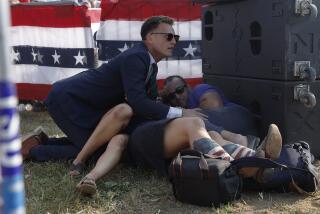Centerpiece : Patriots of a...
- Share via
When Fred Romero walks into a debate, he expects to be outnumbered.
“I’m always told that it will be a fair forum,” he says. “But wherever I go, I fully expect . . . all the buzzwords and catch phrases and gut-grabbers, the emotion, the misinformation. I expect a strong anti-gun slant.
“I’m never disappointed.”
Romero is the National Rifle Assn.’s Southern California field representative. He took the job in 1988, after four years in the Marine Corps, 20 years in the Los Angeles Police Department and one year as a fraud investigator for an insurance company.
“The insurance business is quite boring,” he says.
The art of NRA spokesmanship is not. From an office in Simi Valley, Romero, 46, fights day and night against restrictions on gun ownership, acting as the NRA’s point man before the media and public of Southern California.
While a full-time lobbyist in Sacramento handles the political agenda, Romero faces the cameras and fills the hot seat at forums on firearm regulation. When someone commits a high-profile crime with a gun and the media wants a response, it’s Romero they call.
“I’ve spent my whole life preparing for this job,” he says, citing his background in weaponry, human relations and criminal issues. “There’s an extreme amount of pressure. And yeah, there is a burnout factor.”
The NRA, which carries an $80-million annual budget, employs 20 other representatives across the country. They speak for about 2.7 million dues-paying members (at $25 a year each), whom Romero describes as “very devout.”
“The purest motivator that I have,” he says, “is that I genuinely believe that I am defending the Constitution of the United States as it pertains to the Second Amendment. I believe from the bottom of my heart that the Founding Fathers meant for the common man and the common woman to make legal use of legal firearms.”
Many Americans disagree with his interpretation, the result, to Romero’s mind, of a “biased” news media and a public that is “intellectually lazy, especially when it comes to researching the hard issues.”
Nevertheless, that public is courted assiduously by both the NRA and opposing groups advocating stricter regulation. When the two sides meet, statistics fly. Romero is always ready with his numbers.
Citing national crime figures, he says, “Of approximately 200 million guns in this country . . . less than .3% is ever used criminally. That means that 99.7% of all the guns owned in America are kept legally and safely, and aren’t abused.”
(At Handgun Control Inc., one of the NRA’s most frequent foes, spokeswoman Heather Morse asserts that handguns kill 10 American children a day, that 60% of children who commit suicide do it with guns, that 135,000 boys carry a gun to school every day.)
Romero, who was raised in South-Central Los Angeles and attended classes at Santa Monica Community College, joined the NRA as a rank-and-file member at about the time he became a police officer. During his years on the force, most of them spent as a patrol officer, he was a member of the Los Angeles police pistol team.
His biggest challenge as an NRA professional, he says, came in January, 1989, when gunman Patrick Edward Purdy shot and killed five children at Cleveland Elementary School in Stockton, then killed himself.
“The public sentiment was deeply set against gun owners, and of course the up-front organization was the NRA,” Romero says. “Every forum I walked into, it was an uphill battle. And that was really a trial by fire, because I’d only been on the job for six months.”
His aim in such cases, Romero says, is to persuade the public that weapons curbs can harm the rights of legitimate gun users more than they prevent the illicit activities of criminals.
A week in late June put Romero in Las Vegas to work a booth at a gun collectors’ show; in Chino to observe the opening of the NRA-sponsored U.S. International Shooting Championships, and in Hollywood for a television interview.
Romero enjoys the gun show appearances, and they’re a chance to mingle with people who share his views. But ultimately, he says, they’re not what his job is about.
“I’d rather go out there among the ranks of the enemy,” he says. “I’d rather be in a hostile environment.”
More to Read
Get the L.A. Times Politics newsletter
Deeply reported insights into legislation, politics and policy from Sacramento, Washington and beyond. In your inbox twice per week.
You may occasionally receive promotional content from the Los Angeles Times.











